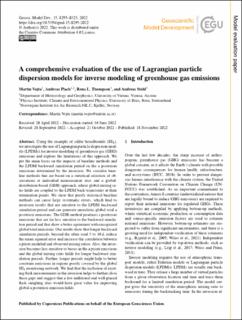| dc.contributor.author | Vojta, Martin | |
| dc.contributor.author | Plach, Andreas | |
| dc.contributor.author | Thompson, Rona Louise | |
| dc.contributor.author | Stohl, Andreas | |
| dc.date.accessioned | 2022-12-15T13:10:41Z | |
| dc.date.available | 2022-12-15T13:10:41Z | |
| dc.date.created | 2022-12-13T11:19:35Z | |
| dc.date.issued | 2022 | |
| dc.identifier.citation | Geoscientific Model Development. 2022, 15, 8295-8323. | en_US |
| dc.identifier.issn | 1991-959X | |
| dc.identifier.uri | https://hdl.handle.net/11250/3038038 | |
| dc.description.abstract | Using the example of sulfur hexafluoride (SF6), we investigate the use of Lagrangian particle dispersion models (LPDMs) for inverse modeling of greenhouse gas (GHG) emissions and explore the limitations of this approach. We put the main focus on the impacts of baseline methods and the LPDM backward simulation period on the a posteriori emissions determined by the inversion. We consider baseline methods that are based on a statistical selection of observations at individual measurement sites and a global-distribution-based (GDB) approach, where global mixing ratio fields are coupled to the LPDM back-trajectories at their termination points. We show that purely statistical baseline methods can cause large systematic errors, which lead to inversion results that are sensitive to the LPDM backward simulation period and can generate unrealistic global total a posteriori emissions. The GDB method produces a posteriori emissions that are far less sensitive to the backward simulation period and that show a better agreement with recognized global total emissions. Our results show that longer backward simulation periods, beyond the often used 5 to 10 d, reduce the mean squared error and increase the correlation between a priori modeled and observed mixing ratios. Also, the inversion becomes less sensitive to biases in the a priori emissions and the global mixing ratio fields for longer backward simulation periods. Further, longer periods might help to better constrain emissions in regions poorly covered by the global SF6 monitoring network. We find that the inclusion of existing flask measurements in the inversion helps to further close these gaps and suggest that a few additional and well-placed flask sampling sites would have great value for improving global a posteriori emission fields. | en_US |
| dc.language.iso | eng | en_US |
| dc.rights | Navngivelse 4.0 Internasjonal | * |
| dc.rights.uri | http://creativecommons.org/licenses/by/4.0/deed.no | * |
| dc.title | A comprehensive evaluation of the use of Lagrangian particle dispersion models for inverse modeling of greenhouse gas emissions | en_US |
| dc.title.alternative | A comprehensive evaluation of the use of Lagrangian particle dispersion models for inverse modeling of greenhouse gas emissions | en_US |
| dc.type | Peer reviewed | en_US |
| dc.type | Journal article | en_US |
| dc.description.version | publishedVersion | en_US |
| dc.rights.holder | © Author(s) 2022. | en_US |
| dc.source.pagenumber | 8295-8323 | en_US |
| dc.source.volume | 15 | en_US |
| dc.source.journal | Geoscientific Model Development | en_US |
| dc.identifier.doi | 10.5194/gmd-15-8295-2022 | |
| dc.identifier.cristin | 2092450 | |
| cristin.ispublished | true | |
| cristin.fulltext | original | |
| cristin.qualitycode | 2 | |

